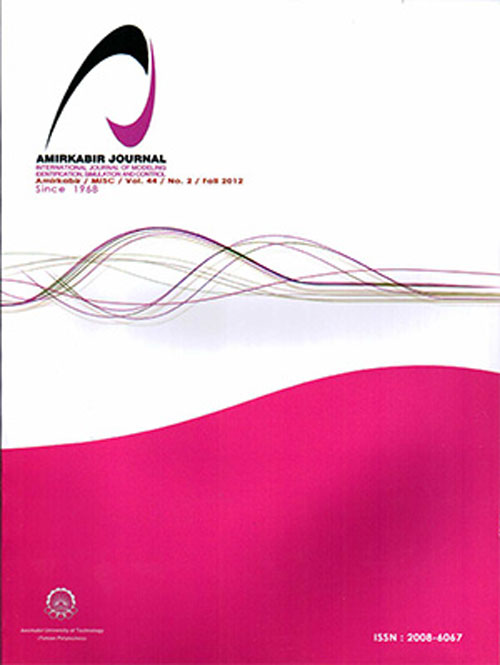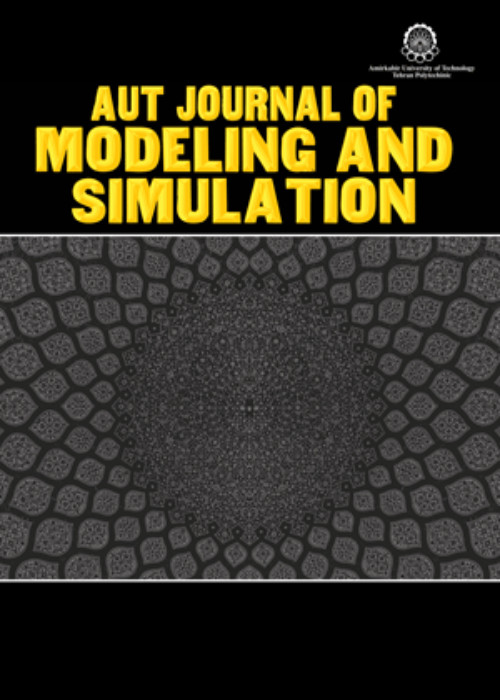فهرست مطالب

Journal of Modeling and Simulation
Volume:47 Issue: 2, Autumn 2015
- تاریخ انتشار: 1394/06/25
- تعداد عناوین: 6
-
-
Pages 1-9The problem discussed in this paper is the effect of latency time on the OGY chaos control methodology in multi chaotic systems. The Smith predictor, rhythmic and memory strategies are embedded in the OGY chaos control method to encounter loop latency. A comparison study is provided and the advantages of the Smith predictor approach are clearly evident from the closed loop responses. The complex plants considered are coupled chaotic maps controlled by the extended OGY scheme. Simulation results are used to show the effectiveness of the applied Smith predictor scheme structure in multi chaotic systems.Keywords: Chaos, Latency in multi chaotic systems, OGY, Smith Predictor
-
Pages 11-19This paper presents a new observer design methodology for a time varying actuator fault estimation. A new linear matrix inequality (LMI) design algorithm is developed to tackle the limitations (e.g. equality constraint and robustness problems) of the well known so called fast adaptive fault estimation observer (FAFE). The FAFE is capable of estimating a wide range of time-varying actuator fault signals via augmenting the Luenberger-observer by a proportional integral fault estimator feedback. Within this framework, the main contribution of this paper is the proposal of new LMI formulation that incorporates the use of norm minimization: (a) to obviate the FAFE equality constraint in order to relax the design algorithm, (b) to ensure robustness against external disturbances, (c) to provide additional degrees of freedom to solve the infeasible optimization problem via assigning different proportional and integral fault estimator gains. Finally, a VTOL aircraft simulation example is used to illustrate the effectiveness of the proposed FAFE.Keywords: fault estimation, fault diagnosis, adaptive observer, robust observer design, fast fault estimation
-
Pages 21-29Cognitive Architectures (CAs) are the core of artificial cognitive systems. A CA is supposed to specify the human brain at a level of abstraction suitable for explaining how it achieves the functions of the mind. Over the years a number of distinct CAs have been proposed by different authors and their limitations and potentials were investigated. These CAs are usually classified as symbolic and sub-symbolic architectures. In this work, a novel hybrid architecture is proposed that encompasses a symbolic part (i.e. ACT-R) to explain the controlled aspects of behavior and a sub-symbolic part (i.e. Artificial Neural Networks) to describe automated skills. In order to demonstrate the capabilities of the proposed model, an experiment was conducted in which, a rather complex real life task was carried out by the model and its result were compared with those of human participants. Simulation results have shown promising capabilities of the new architecture in modeling complex human behavior.Keywords: Cognitive Architecture, Neural Networks, Cognitive Dynamic Systems, Driver Modeling, Neuro, ACT
-
Pages 31-43Steering assist system controls the force transfer behavior of the steering system and improves the steering probability of the vehicle. Moreover, it is an interface between the diver and vehicle. Fault detection in electrical assisted steering systems is a challenging problem due to frequently use of these systems. This paper addresses the fault detection and reconstruction in automotive electrical steering assist systems. Two types of faults including sensor fault and actuator fault are investigated. In this paper, four different model-based fault detection methods including Luenberger observer method, Parity space method, decoupling filter of fault from disturbance method and the unknown input observer are studied. In each method, a sensor and actuator fault is investigated based on the model of the system. Moreover, we examine a method for the fault reconstruction based on the sliding mode observer. Finally, these methods are applied to an automotive electrical steering assist system. The results are presented and thoroughly discussed.Keywords: Fault detection, Fault reconstruction, Parity space, Sliding mode, Unknown input observer
-
Pages 45-56Based on dynamic modeling, robust trajectory tracking control of attitude and position of a spherical mobile robot is proposed. In this paper, the spherical robot is composed of a spherical shell and three independent rotors which act as the inner driver mechanism. Owing to rolling without slipping assumption, the robot is subjected to two nonholonomic constraints. The state space representation of the system is developed using dynamical equations of the robot’s motion. As the main contribution, a dynamical model based SMC (sliding mode controller) is designed for position and attitude control of the robot under parameters uncertainty and unmodeled dynamics. To decrease the chattering phenomena originated by the sign function, the well-known boundary layer technique is imposed on the SMC. The control gains are determined through using Lyapunov’s direct method in such a way that the robustness and to zero convergence of the controller’s tracking error are guaranteed. Computer simulations are performed to show the significant tracking performance of the proposed SMC in particular against parameters uncertainty and white Gaussian noises. The simulation results show the significant performance of the designed nonlinear control system in trajectory tracking control as well as in attitude control of the spherical robot even in the presence of parameters uncertainty and measurement noises.Keywords: Spherical robot, Nonholonomic System, Sliding mode control, Boundary Layer, Parameter's uncertainty
-
Pages 57-66Agents, in a multi agent system, communicate with each other through the process of exchanging messages which is called dialogue. Multi agent organization is generally used to optimize agents’ communications. Holonic organization demonstrates a self-similar recursive and hierarchical structure in which each holon may include some other holons. In a holonic system, lateral communication occurs between members of a determined holon and vertical communications are inter-level ones between different holons. When agents start a dialogue, according to their beliefs, they follow some rules that define the permissive speech acts called dialogue protocol. The dialogue strategy is the policy of agents to choose a particular speech act among the allowed ones by the protocol in order to achieve the common goals of holon. In this paper a formal model for dialogue strategy for lateral communication in a holon is proposed. This model tries to choose the most preferable speech acts considering at the same time local beliefs and goals along with public knowledge obtained from holonic organization. Moreover, the argumentation theory is applied to rank and define the values of speech acts. The proposed model finds the most preferable option to utter and it also decreases the number of exchanging messages. The proposed model of dialogue strategy is illustrated via a deliberation dialogue example in a holon. The example showed a significant efficiency in decreasing the number of exchanged messages and the effectiveness of deliberation.Keywords: Holonic Multi Agent Systems, Lateral Communication, Dialogue Strategy, Argumentation


